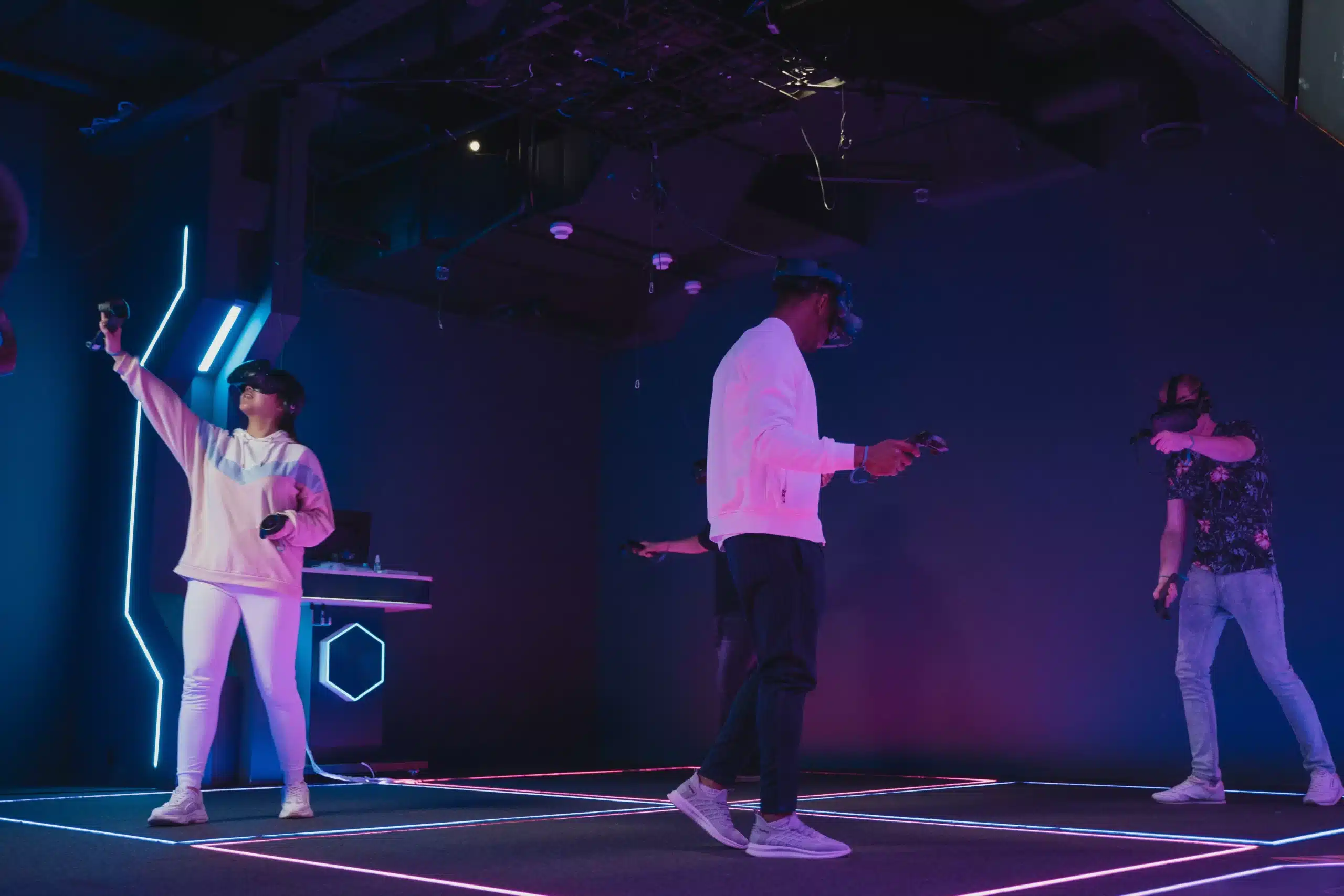The gaming industry is in the midst of an exhilarating era with the release of next-generation gaming consoles, each promising a leap forward in performance, graphics, and gaming experiences. In this comprehensive comparison, we delve into the latest releases from major players in the gaming console market, exploring the features, specifications, and unique selling points of each. Whether you’re a dedicated gamer looking to make an informed purchase or a tech enthusiast keeping an eye on the gaming landscape, this article aims to provide an in-depth analysis of the current state of next-gen gaming consoles.
Introduction to Next-Gen Gaming Consoles:

1. Sony PlayStation 5 (PS5):
- Release Date: November 12, 2020 (North America, Japan, Australia, New Zealand), November 19, 2020 (Rest of the World).
- Processor: Custom AMD Ryzen Zen 2 Octa-core CPU.
- Graphics: Custom AMD RDNA 2 GPU with ray tracing.
- RAM: 16 GB GDDR6.
- Storage: 825 GB NVMe SSD.
- Optical Drive: 4K UHD Blu-ray.
- Key Features: DualSense Wireless Controller with haptic feedback and adaptive triggers, 3D audio technology, backward compatibility with most PS4 games.
2. Microsoft Xbox Series X:
- Release Date: November 10, 2020.
- Processor: Custom AMD Ryzen Zen 2 Octa-core CPU.
- Graphics: Custom AMD RDNA 2 GPU with ray tracing.
- RAM: 16 GB GDDR6.
- Storage: 1 TB NVMe SSD.
- Optical Drive: 4K UHD Blu-ray.
- Key Features: Xbox Wireless Controller with textured grip, backward compatibility with thousands of Xbox, Xbox 360, and Xbox One games, Xbox Game Pass subscription service.
3. Microsoft Xbox Series S:
- Release Date: November 10, 2020.
- Processor: Custom AMD Ryzen Zen 2 Octa-core CPU.
- Graphics: Custom AMD RDNA 2 GPU.
- RAM: 10 GB GDDR6.
- Storage: 512 GB NVMe SSD.
- Optical Drive: Digital-only.
- Key Features: Smallest Xbox ever, focused on digital gaming, backward compatibility, Xbox Game Pass subscription service.
Performance and Graphics:
1. Sony PlayStation 5 (PS5):
- Performance: Powerful performance with an octa-core processor and high-speed SSD for quick loading times.
- Graphics: Custom RDNA 2 GPU with ray tracing for realistic lighting and reflections.
- Frame Rate: Supports up to 120 frames per second for smooth gaming experiences.
2. Microsoft Xbox Series X:
- Performance: High-performance hardware with an octa-core processor and a fast SSD.
- Graphics: RDNA 2 GPU with ray tracing capabilities.
- Frame Rate: Supports up to 120 frames per second for immersive gaming.
3. Microsoft Xbox Series S:
- Performance: Solid performance with a focus on digital gaming.
- Graphics: Custom RDNA 2 GPU for an enhanced visual experience.
- Frame Rate: Supports up to 120 frames per second, ensuring a responsive gaming environment.
Storage and Expandability:
1. Sony PlayStation 5 (PS5):
- Storage: 825 GB NVMe SSD for fast loading times and data transfer.
- Expandability: Supports NVMe SSD expansion for additional storage.
2. Microsoft Xbox Series X:
- Storage: 1 TB NVMe SSD for ample storage.
- Expandability: Proprietary 1 TB expansion card for additional storage.
3. Microsoft Xbox Series S:
- Storage: 512 GB NVMe SSD for efficient storage.
- Expandability: Proprietary 1 TB expansion card for additional storage.
Backward Compatibility:
1. Sony PlayStation 5 (PS5):
- Backward Compatibility: Compatible with the majority of PlayStation 4 games.
- Enhancements: Some games receive enhancements like higher frame rates and improved graphics.
2. Microsoft Xbox Series X:
- Backward Compatibility: Extensive backward compatibility, supporting thousands of Xbox, Xbox 360, and Xbox One games.
- Enhancements: Many older games receive improvements in performance and visuals.
3. Microsoft Xbox Series S:
- Backward Compatibility: Supports a wide range of Xbox, Xbox 360, and Xbox One games.
- Enhancements: Older titles benefit from improved performance and graphics.
Controller Innovation:
1. Sony PlayStation 5 (PS5):
- DualSense Controller: Features haptic feedback and adaptive triggers for a more immersive gaming experience.
- Built-in Microphone: Allows voice commands without the need for a headset.
2. Microsoft Xbox Series X:
- Xbox Wireless Controller: Features textured grip and a refined design for comfortable gaming.
- Share Button: Allows easy sharing of screenshots and game clips.
3. Microsoft Xbox Series S:
- Xbox Wireless Controller: Similar to the Series X controller with a focus on comfortable gameplay.
- Share Button: Enables quick sharing of gaming moments.
Subscription Services:
1. Sony PlayStation 5 (PS5):
- PlayStation Plus: Offers monthly free games and access to online multiplayer.
- PlayStation Now: Cloud gaming service with a library of games.
2. Microsoft Xbox Series X:
- Xbox Live Gold: Provides access to online multiplayer and free monthly games.
- Xbox Game Pass: Subscription service with a vast library of games, including day-one releases.
3. Microsoft Xbox Series S:
- Xbox Live Gold: Offers online multiplayer and free monthly games.
- Xbox Game Pass: Access to a large library of games, including Xbox Game Pass Ultimate for cloud gaming.
Design and Form Factor:
1. Sony PlayStation 5 (PS5):
- Design: Futuristic design with a white and black color scheme.
- Form Factor: Larger and bulkier compared to previous PlayStation consoles.
2. Microsoft Xbox Series X:
- Design: Tower-like design with a black color scheme.
- Form Factor: Sturdy and compact, resembling a mini-ITX PC case.
3. Microsoft Xbox Series S:
- Design: Compact design with a white color scheme.
- Form Factor: The smallest Xbox console, emphasizing digital gaming.
Price Point:
1. Sony PlayStation 5 (PS5):
- Retail Price: Typically priced slightly higher than the Xbox Series X.
- Availability: Demand often outstrips supply, leading to occasional shortages.
2. Microsoft Xbox Series X:
- Retail Price: Generally priced slightly lower than the PS5.
- Availability: Like the PS5, the Series X may experience supply shortages.
3. Microsoft Xbox Series S:
- Retail Price: Priced lower than both the PS5 and Series X.
- Availability: The Series S is often more readily available compared to its counterparts.
Exclusive Games:
1. Sony PlayStation 5 (PS5):
- Exclusives: Strong lineup of exclusive titles, including “Demon’s Souls,” “Ratchet & Clank: Rift Apart,” and “Returnal.”
2. Microsoft Xbox Series X:
- Exclusives: Limited exclusive titles at launch, with a focus on backward compatibility and Game Pass.
3. Microsoft Xbox Series S:
- Exclusives: Similar to the Series X, limited exclusive titles at launch, with a focus on backward compatibility and Game Pass.
The Future of Next-Gen Gaming:
1. Technological Advancements:
- Ray Tracing: Continued advancements in ray tracing technology for more realistic graphics.
- Higher Frame Rates: Games aiming for even higher frame rates for smoother animations and responsive gameplay.
2. Cloud Gaming:
- Expansion of Cloud Services: Further expansion of cloud gaming services for streaming games without the need for powerful hardware.
- Integration with Subscription Services: Integration of cloud gaming into existing subscription services.
3. Virtual Reality (VR):
- VR Integration: Exploration of VR integration for a more immersive gaming experience.
- Dedicated VR Titles: Development of exclusive VR titles to drive adoption.
4. Cross-Platform Play:
- Increased Cross-Platform Compatibility: Growing emphasis on cross-platform play to unite gaming communities.
- Cross-Save and Cross-Progression: Seamless transfer of game progress across different platforms.
5. Evolving Controller Designs:
- Innovative Controllers: Continued innovation in controller design to enhance immersion and accessibility.
- Integration of Biometrics: Potential integration of biometric features for more personalized gaming experiences.
Conclusion: Choosing Your Next-Gen Gaming Console
The landscape of next-gen gaming consoles is rich with options, each catering to different preferences and gaming priorities. Choosing the right console involves considering factors such as performance, exclusive games, subscription services, and budget constraints.
If you prioritize an extensive library of games and value subscription services, the Xbox Series X or Series S, with the Xbox Game Pass, might be an attractive option. However, if exclusive titles and a unique gaming experience are your focus, the PlayStation 5, with its strong lineup of exclusives and innovative controller, could be the ideal choice.
Ultimately, the next-gen gaming experience is shaped not only by the hardware but also by the community, services, and games available on each platform. As the gaming industry continues to evolve, the future promises exciting developments, and the choice between PlayStation and Xbox becomes not just a matter of hardware, but a gateway to immersive worlds, thrilling adventures, and boundless possibilities for gamers around the globe.

Erwin Wallace is an avid gamer and a passionate writer who specializes in the world of online video games. With a deep-rooted love for virtual adventures and competitive gaming, Erwin’s blogs provide valuable insights, tips, and reviews on the latest online gaming trends. He has an uncanny ability to dissect game mechanics, strategies, and gaming culture, making his content a must-read for fellow gamers.
contact: [email protected]
